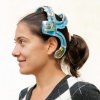Wearable medical devices are autonomous, non-invasive devices that perform specific medical functions such as managing treatment of chronic diseases or monitoring vital signs of human body. A wearable medical device incorporates capabilities such as wireless data transmission, real time feedback and assessment and so on. During the forecast period of 2015-2020, the market is projected to grow remarkably at 21.3% to generate revenue of $41.3 billion by 2020.
Wearable medical devices offer various solutions to both, patients as well as physicians or health care providers. These solutions can primarily be classified into four categories, namely therapeutic purposes or disease management; monitoring and feedback, assisting in rehabilitative processes and health & fitness purposes. Monitoring and diagnostic wearable devices accounted for the majority share of 78% in the global wearable medical device market in 2014. This segment is estimated to generate revenue of $34.4 billion by 2020.
The market for wearable medical devices has seen a dramatic rise in recent years owing to factors such as increase in health consciousness among people, overall health trends to move care from hospitals to homes and subsequently to personal care and so on. As a result, medical device manufacturers are shifting their focus from fully fixed equipment to portable devices and more recently to wearable ones. Further, with innovation and advancements in wearable technology, specifically miniaturization of sensor technology, wireless communication technology, and wearable computational technology has made possible the development of small, light, durable, comfortable, safe and low cost wearable medical devices. The miniaturization of wearable devices has also enabled clinical monitoring beyond the hospital area, to the home or during outdoor activities.
Based upon their design and technical features, wearable medical devices have found usage in three specific areas, namely - Home Health Care, Remote Patient Monitoring and Fitness & Sports. In 2014, the home-healthcare constituted the largest end-user group, accounting for 68% of the global wearable medical device market revenue. These devices are widely preferred by people who want to live independently at their own homes and lead an active life, without support of others. Aging population and increase in prevalence of chronic diseases have led to a high demand of home healthcare, wherein accurate treatment control and vital signs monitoring is essential. Sports and fitness also held a major share of the wearable medical device market in 2014 and is poised to exhibit a growth of 22.2% over 2015 - 2020. The growing demand for fitness and sports wearable devices is driven by rise in health consciousness and health consumer expenditure.
The wearable technology is creating a future that equips the consumers with devices to ensure their health and fitness. Consumers are giving more importance to wearable health devices that can make them more aware about their daily life schedule. Furthermore, the millennial has evolved themselves into more information oriented generation that has been facilitated by the revolution in computing technology. The consumers belonging to this generation want data to be present at their fingertips that can be further evaluated to gain significant perspective. As the consumers from this age group are becoming more health conscious than their predecessors amidst the fast paced life, the wearable medical devices market is set to grow. Keeping in mind the expectations of today's fast paced generation; device manufacturers are frequently collaborating with designers and developers to cater to several types of enthusiasts including sports, fitness and health. The customer demand for wearable technology is projected to lead to growth from around 100 million devices shipped in 2014 to nearly 300 million devices shipped in 2020 according to the Wearable Technology Association. Consumers particularly belonging to younger generation are set to opt for wearable devices and thereby, compliment their market growth.
However, the high costs for the wearable devices act as constraint for mass adoption of wearable devices globally. The price sensitivity, particularly in the APAC market, has hindered the growth of wearable medical devices. The high price of wearable medical devices has been a barrier for penetration of these devices in the market. Also, stringent government regulations with regards to wearable medical devices are likely to hinder the entry of new devices in the market resulting in slower growth.
The top five companies in the Wearable Medical Devices market include Zephyr Technology Corp., Omron Healthcare, Inc., Basis Science, Sotera Wireless, Inc., and Polar Electro Oy. Though these companies have a dominant position in the market, there are a few companies such as Philips Healthcare, ResMed, Fitbit, Inc, giving stiff competition to the top players with their innovative product designs. The big players are launching new products and acquiring the smaller companies, to augment their product portfolio and also to develop innovative products by leveraging the core competencies, thereby enhancing their product portfolio. Companies are also looking at acquisitions in this market to expand their capabilities and position themselves in this growing market.
source:The Borneo Post
Wearable Medical Device Market To Grow 21% Through 2020

